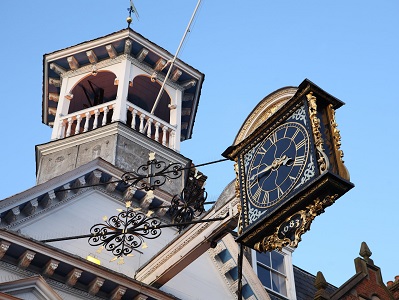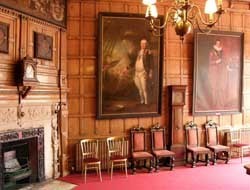
Guildford High Street is truly unique with some very distinctive buildings. There is a red brick church, a gate house looking like it comes from Hampton Court, a Greek arch but pride of place must be the Guildhall with its famous clock
The clock is beautiful and you can see the date 1683. The story is that a London clock maker, John Aylwood, wanted to set up shop in Guildford. In order to persuade the authorities to give him permission he made them a clock. I wonder if they were surprised by the size of it. In fact they had to rebuild the entire front of the Guildhall to accommodate it.
Before going in let’s take a look at the outside. Some people say the design looks like the stern of an old sailing ship and one wonders if that was the inspiration. It was the Council chamber where the Approve Men who ran the town met. They were replaced by elected Councillors after 1835 and the town was run from here until the 1930s. It was also here that people came to vote at election time and where the results were announced. In the middle of the nineteenth century elections were wild affairs. Most people did not have the vote but made their views known by turning up with banners and shouting. The well to do would turn up to vote outside Holy Trinity Church and the crowds would try to influence them. Another wild event were the bonfire parties that took place in High Street. Things got out of hand and riots broke out. If you look up a the turret you can see the bell that was rung to summon special constables to tackle the riots. Bonfires led to fires and it was also here at the Guildhall that an old fire engine was kept. In the middle of the nineteenth century it was run by three butchers and the ladders, horses and buckets were held in different parts of the town. When a fire broke out at night the firemen had to be woken and then they had to run round the town finding their equipment and catching the horses. They frequently arrived at fires too late

Lets now go in. As you go in there is a long list of mayors of Guildford. Downstairs was the court room. Notice the sign saying “Be Just and Fear not”. This room was also used for public meetings and still is. It does not look that old but if you look up you can see the ancient rafters. This is a sixteenth century hall and it is easy to imagine a different scene with straw on the floor, rough wooden tables, perhaps a fire burning on the floor and important people standing around discussing the town’s business. This room was a courst room until the 1970s. The stairs by the dock once went down the police station cells. The police station was in North Street.



Lets go upstairs. Here is held the town plate and ceremonial swords. At the front is a very different room – a grand seventeenth century panelled room. Along the sides are high backed chairs from the period and grand paintings on the wall. One of the paintings shows the costume of the type of person who would have been here – except that he would probably have had a long wig – that was the fashion about the time this room was build. There are some fine paintings along the wall of Kings of the period. The choice of paintings remind us of the age these people lived in. When this room was built, England would have still been recovering from the Civil war (1642 to 49). The people who sat here would have remembered those times but had enjoyed 20 years of peace until Charles II. Guildford was always loyal to the crown and this loyalty is seen in these paintings